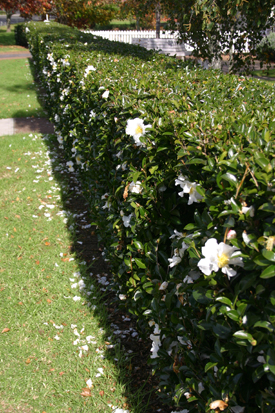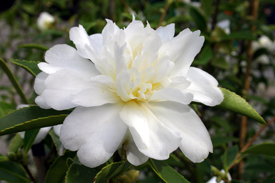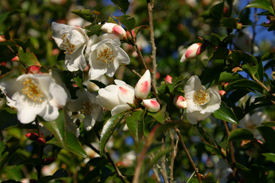Multi-talented camellias
They’re like the roses of winter. There is no doubting the beauty of camellia flowers; their shapes, colours and perfumes. But in a world not short of spectacular blooms, camellias offer so much more.
As tough evergreen shrubs with attractive foliage camellias provide structure and substance to the garden all year round, and can be grown with ease in a wide range of climates. Versatile camellias offer a huge variety of different growth habits. Take your pick from tightly compact or stiffly upright, wide and spreading, willowy and weeping, or tall and tree-like.
When they’re not in flower, camellias make an attractive plain green backdrop for other plants. They’re adaptable to a huge range of landscape uses, and fit any size or style of garden.
Camellias as hedges
Whether you want a hedge that’s tall, short, narrow or wide, there is a camellia to suit the purpose. The early flowering ‘sasanqua’ and ‘hybrid’ camellias are especially good as hedges. Some hybrid camellias have an exceptionally long flowering season, from autumn till spring. If you love a hedge that is smothered in winter colour, consider the extremely free flowering ‘Paradise’ camellias.
Favourite Camellia hedges:
- Bonanza (hot pink double)
- Early Pearly (white double)
- Gay Border (pink and white single)
- Setsugekka (white single)
- Silver Dollar (white double)
- Paradise Camellias
- Yuletide (red single, very compact)
Camellias in containers
Any camellia can be grown in a pot, but for longer term container camellias choose small growing cultivars and those described as ‘compact’ or ‘slow growing’. Repot into fresh potting mix every two or three years. It is possible to trim the roots if you wish to keep them in the same pot, but always repot into fresh potting mix and ideally, repot into a slightly larger container each time. If the pot is too large for the plant the roots may suffer from sitting in excessive cold damp mix. Drainage is very important. Plants growing in containers need frequent watering and more feeding then those in the ground.
Camellias for containers:
- Bonzai baby (hot pink double)
- Itty Bit (soft pink)
- Nicky Crisp (pink)
- Quintessence (pale pink)
- Silver column (white)
- Transnokoensis (white with a hint of pink)
- Yuletide (red single, very compact)
Camellias for topiary
Look for small leafed camellias with compact growth so you can train them as a lollipop shape and keep them neat with regular trimming. The main trim should be in winter or spring, after flowering and before the new flush of growth.
Camellias for narrow spaces
Camellias with an upright habit that stays slender without too much trimming are ideal for narrow spaces. ‘Silver Column’ has a pronounced column shape. Other upright growers are ‘Transpink’, ‘Cinnamon Cindy’, ‘Fairy Blush’ and ‘Early Pearly’.
To keep a camellia confined to a tight space, prune each year after flowering to shorten the side branches. This will encourage more branching (and hence more flowers) to grow close in to the main trunk.
Camellias on walls
Varieties with supple willowy branches can be trained as an espalier against a wall or fence.
Camellias as trees
A large shrub in a large garden is a small tree in a small garden. Tall growing camellias offer flowers in every size from tiny species to big blowsy japonica and reticulata varieties. The old-fashioned reticulata camellias such as ‘Guillio Nuccio’ and ‘Elegans Champagne’ have stunning blooms (great for picking) and will form a graceful tree shape with age. Encourage a tree like structure by removing lower branches as the plant grows.
For all the tea in China
Camellias were highly prized plants long before anyone got excited about breeding them for their ornamental beauty. For thousands of years they’ve featured in food, industrial oils, fuel, textiles, medicines, cosmetics and most importantly - in tea. It was because of that treasured beverage that camellias first arrived in Europe in the 17th century. The tea plant (Camellia sinensis) is grown in tropical and subtropical regions across the globe. About a third of the world’s production is in China.
Growing camellias
- Generally part shade is ideal for camellias, especially the pale colours. Most will tolerate sun, but the more sun; the more watering will be required. Plant where there is shelter from strong wind, which can damage the flowers.
- Plant a well-drained soil enriched with compost and slow release fertiliser. Dig the planting hole at least twice as wide as the root ball and backfill to the depth of the roots. The crown (where roots join stem) should not be buried.
- If planting in pots use top quality container mix, not soil from the garden.
- After planting, add a 5-10cm layer of organic mulch, leaving an air space around the trunk. Because camellia roots grow close to the surface, digging or mowing over them is best avoided.
- Water in dry periods. Newly planted camellias need a thorough soaking every 4 to 5 days. Camellias in pots need daily watering in the heat of summer.
- Feed camellias in spring, ideally as the new foliage emerges, and again in summer. Avoid overdosing with acid fertilisers. Apply these sparingly during spring and summer. The ideal soil for camellias is mildly acidic. Most New Zealand gardens have naturally acidic soil. Use slow release fertiliser at planting time. Use only slow release fertilisers for camellias in pots.
- Trim if necessary to control shape or to remove diseased or dead wood. The ideal time is in winter or late spring before the flush of growth. An old overgrown camellia can be rejuvenated with heavy pruning in late winter.
11-Jun-2013

Camellia sasanqua 'Setsugekka'

Camellia 'Transpink'

Camellia 'Snow Flurry'

Camellia 'Transnokoensis'


